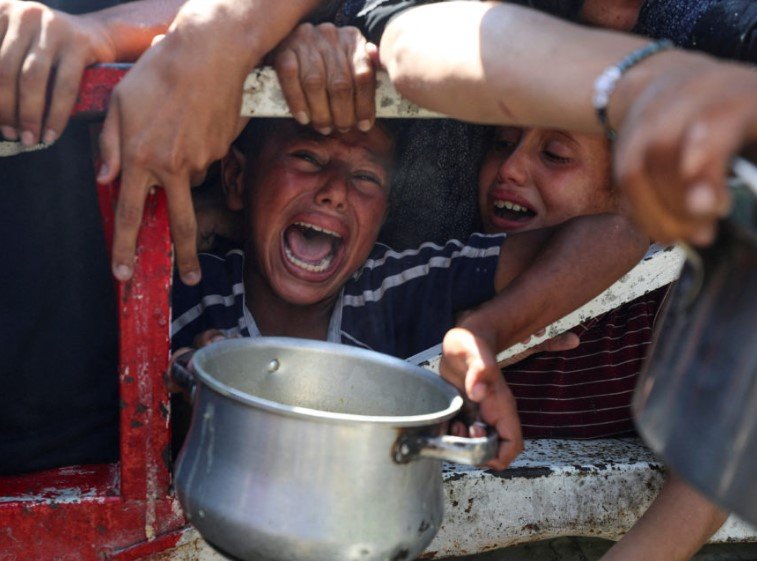Deadly raids hit ‘safe zones’ as malnutrition toll climbs and promised humanitarian corridors falter
Israel’s military campaign in Gaza claimed at least 63 more lives over the weekend, even as the army publicly committed to daily “humanitarian pauses” to allow food and medicine into the devastated enclave. Among the dead: children, bakery workers, and families who had taken refuge in areas Israeli authorities had labeled as safe.
The attacks resumed within hours of the so-called ceasefire window opening. At the same time, Gaza’s Health Ministry reported six additional deaths caused by malnutrition—two of them children—bringing the total starvation toll to 133 since October 2023.
Ceasefire in Name Only
On paper, the Israeli military had taken a new step. Beginning Sunday, it promised daily halts in fighting from 10 a.m. to 8 p.m. across select regions: al-Mawasi, Deir el-Balah, and parts of Gaza City.
The idea was simple: give aid workers time and space to move.
But in practice?
“An airstrike hit Gaza City by noon,” said Al Jazeera’s Hind Khoudary. “People were baking bread. Some thought they were finally safe.”
One sentence. That’s all it took to dismantle the illusion.

Targeting Amid the Pause
There were several strikes. Not just one. Gaza’s Civil Defense reported that among the locations hit was a bakery, a school shelter, and a residential block.
One man, Youssef al-Masri, stood outside what remained of a distribution center in Deir el-Balah. He had been waiting for lentils and canned tuna. Instead, he found bodies.
“Every day they say ‘safe zone,’ but every day people die,” he said. “Even the bread is afraid now.”
The Israeli military claimed it was targeting “Hamas infrastructure embedded in civilian areas,” without confirming if these strikes occurred during the declared pause hours.
Rising Toll of Hunger
While bombs fall, Gaza’s people are starving.
The local Health Ministry said six more people died from hunger-related causes in just 24 hours. Two were under the age of five.
The total now stands at 133 starvation deaths since the war began. But aid workers say that number could be much higher—many cases go unreported, or are hidden behind other causes like dehydration or infections.
“Children are arriving at clinics skeletal,” one MSF nurse in Khan Younis told Le Monde. “Their skin is loose. Their eyes don’t blink.”
One paragraph. One visual. That’s the entire humanitarian collapse.
Promises, Corridors, and Chaos
The Israeli army had also promised to open two “designated corridors” for humanitarian aid—active between 6 a.m. and 11 p.m. But access remains chaotic and unpredictable.
Here’s what was supposed to happen:
-
Food convoys would move safely through designated lanes
-
Aid groups could store and distribute in “pause zones”
-
Civilian movement would be coordinated
But reports from the ground say convoys were delayed at checkpoints for hours, and some were forced to turn back due to shelling.
“The corridors are imaginary,” said a spokesperson for the Palestinian Red Crescent. “We can’t even get insulin across without risk.”
On the Ground: A Queue for Survival
In Gaza City, hundreds lined up near a makeshift kitchen operated by a local NGO.
Khames Alrefi, a photojournalist with Anadolu, captured the desperation—mothers clutching empty bowls, barefoot children eating from the ground, men weeping as food ran out.
“People aren’t waiting for seconds. They’re waiting for their first meal in two days,” Alrefi said.
One woman, Amal, said she had walked six miles to find food for her three children. “There was rice, but it ended before I got there,” she whispered. “Now I wait again.”
War on Aid: A Global Alarm
International criticism of Israel’s blockade and conduct in Gaza has grown sharper.
A UN special rapporteur last month accused Israel of using starvation as a weapon of war. Human Rights Watch said the same in a June report.
Even allies are raising concerns.
France’s foreign minister called the situation “morally unacceptable.” Ireland demanded “unconditional aid access.” South Africa’s president called the famine deaths “deliberate.”
The pattern is hard to ignore: Israel announces measures, then carries out strikes. Announces corridors, then restricts them. Claims food is moving, then blocks fuel that powers kitchens and transport.
Facts on the Ground: A Snapshot of the Crisis
Table: Gaza Humanitarian Crisis Snapshot (as of July 27, 2025)
| Category | Number/Status | Source |
|---|---|---|
| Civilian Deaths (Past 24h) | 63 | Gaza Health Ministry |
| Starvation Deaths (Total) | 133 | Gaza Health Ministry |
| Aid Corridor Operating Hours | 6 a.m. to 11 p.m. (in theory) | IDF |
| Daily Pause Zone Hours | 10 a.m. to 8 p.m. (in select areas) | IDF |
| Confirmed Strikes During Pause | Multiple | Al Jazeera, Reuters |
What Comes Next?
That’s the question echoing in aid briefings, at family dinner tables lit by candlelight, and in every crumbling clinic trying to stretch IV bags into miracles.
Will these “pauses” mean anything if they don’t pause the killing?
Will the corridors ever become real lanes of hope, or just another photo op?
And will the children of Gaza get to see a day where food isn’t a weapon, and bread isn’t a casualty?
